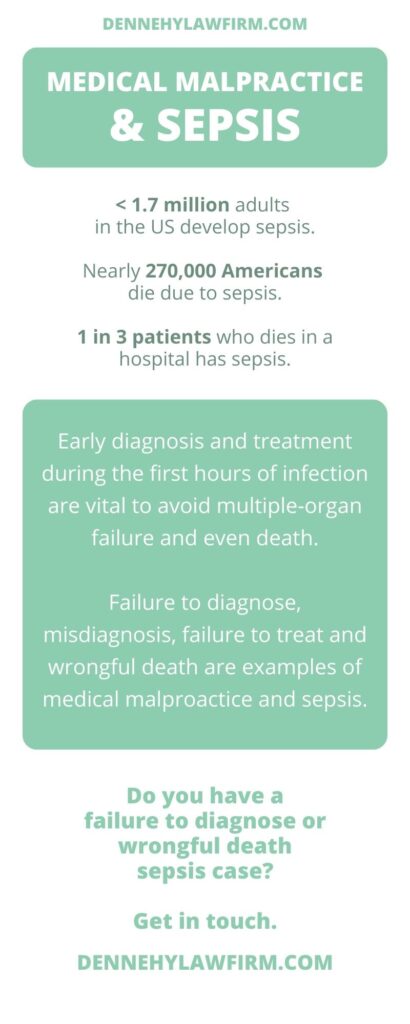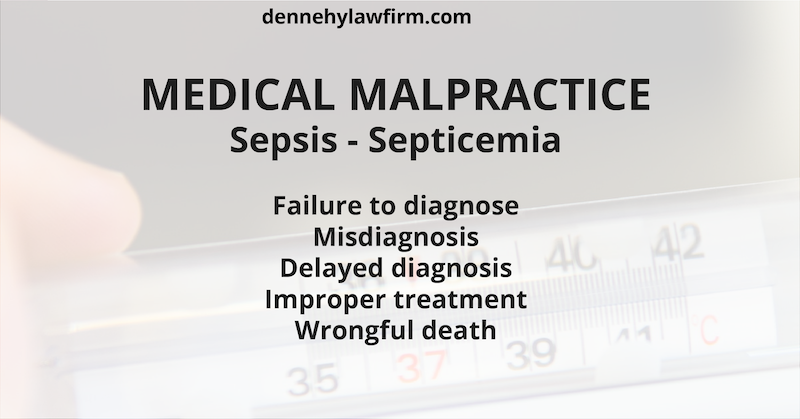Medical negligence or medical malpractice relating to sepsis refers to a case where a lawsuit is filed against a medical professional for substandard medical care that resulted in sepsis and potentially further harmed the patient in question, in some cases even leading to death.
If you or a loved one has been the victim of medical malpractice relating to sepsis, please get in touch today for a free consultation.
Table of Contents
What Is Sepsis?
At the global level, sepsis is the main cause of death due to infection, especially if it is not recognized and treated quickly.
Also known as septicemia or “blood poisoning”, sepsis is a serious infection, or inflammatory condition, caused by bacteria that spreads through the blood and causes the body to injure its own tissues and organs in response to the infection.
The condition is life-threatening if not detected and treated in time.
Any infection can cause sepsis, but it is more common for sepsis to be triggered by infections like pneumonia, urinary tract infection or a skin infection.
Early diagnosis and treatment during the first hours of infection are vital to avoid multiple-organ failure and even death.
More than 1.7 million adults get sepsis annually in the U.S., leading to over 270,000 deaths per year. In fact, it is one of the most common causes of death in hospitals nation-wide. Unfortunately, sepsis is often associated to medical negligence in nursing home care.
Who is at greatest risk for sepsis?
1 in 3 patients that die in the hospital had sepsis. Those are that are most vulnerable to contracting and dying from sepsis include:
- Adults over 65 years of age
- Individuals with a weaker immune system
- Those that suffer from chronic medical conditions (lung diseas, diabetes, kidney diseas, cancer)
- People that have recently been hospitalized due to severe illness
- People that have already survived sepsis
- Children below the age of 1 year
What Are The Symptoms Of Septic Shock?
Sepsis and septic shock are not the same.
Septic shock is a branch of sepsis where metabolic/cellular or underlying circulatory abnormalities may increase the chances of death.
If you have an infection, such as pneumonia or a urinary tract infection – and in addition have one or more of the following symptoms, you may be suffering from septic shock:
- difficulty breathing
- fast pulse
- damp or sweaty skin
- confused or disoriented
- trembling, freezing
- fever
- severe pain or discomfort
There are three stages of septic shock:
Stage 1: In the first stage, the patient will experience a high fever of 95 degrees and an increase in heart rate.
Stage 2: In the second stage, the patient may experience difficulty breathing, abnormal cardiac rate, rapid changes in mental state and reduction in urination.
Stage 3: In the third stage, the patient may enter septic shock where it may be difficult to restore arterial pressure.
What are the causes of sepsis?
When bacteria or other microorganisms enter the bloodstream and the body’s infection defenses overreact, the body’s organs, such as the lungs, kidneys, brain, heart and liver can be damaged and, in the worst case, fail.
What causes sepsis depends on the bacterium that causes the infection and the patient’s general health condition (they may have underlying health conditions that make them more vulnerable).
In most cases of sepsis, it is one’s own bacteria that is the cause. It can be bacteria from the skin, oral cavity or from the intestine, which causes an infection in, for example, the urinary tract or in the lungs.
Negligent Treatment Leading To Sepsis Negligence Claims
Misdiagnosis, failure to diagnose, and failure to treat sepsis or septic shock by a medical professional is defined as negligent treatment leading to sepsis negligence claims.
There are now numerous efficient screening tools for sepsis, or “sepsis bundles” and standardized diagnostic algorithms to identify sepsis.
Nonetheless,sSepsis symptoms can be difficult to diagnose and treat quickly; medical staff must be highly trained and attentive to any warning signs that their patient may be experiencing sepsis or septic shock, particularly in high-risk patients, or in patients that have been admitted but have not been diagnosed with a condition.
Treatment of sepsis and/or septic shock is time-dependent. Unfortunately, it is quite common that a patient exhibits signs of sepsis and/or septic shock but is not properly diagnosed and treated during the most crucial first hours of infection.
While the majority of patients will recover from early-detected sepsis, those that were not correctly diagnosed early on may develop severe sepsis or septic shock and either pass away or experience severe, and often permanent, side effects.
Under staffing is one reason sepsis may go undetected. Too few nurses or medical aides means less surveillance and, in the case of nursing home residents, fewer visits to monitor bedsores and to turn bedridden residents.
Another cause for sepsis is improper training and substandard surveillance, despite there being numerous resources for adult sepsis surveillence.

Sepsis Negligence Claims Process
To make a sepsis claim, you will need to:
- Schedule a call with a medical malpractice attorney specialized in infections
- Prove that your doctor or hospital was responsible for either misdiagnosing, failing to diagnose or failing to treat sepsis. See list below for events relating to this.
- Make sure you submit your claim before the statute of limitations (see next section)
In the case of sepsis, a number or events and documentation can be used to make a claim. For instance:
- Proof that medical professionals did not send you to the hospital or sent you home from the hospital though you were already presenting sepsis symptoms
- Evidence that there was an outbreak (MRSA or other bacteria) in the same hospital which you may have been exposed to
- Evidence that medical staff failed to conduct blood tests though your symptoms were already present
- In the case that blood tests were conducted and returned abnormal, medical staff should have then acted on these results.
- Delays in testing blood or running tests on related areas of the body exhibiting symptoms e.g. MRI of kidneys
- After another type of surgery or childbirth, evidence that antibiotics were not prescribed can also be used in your claim
- Failure to treat tissue damage due to necrosis or abscesses
- In the worst of cases, death due to sepsis-related symptoms and/or organ failure.
If you decide to file a medical malpractice sepsis lawsuit with your attorney, make sure you gather and submit all financial and medical records relating to case events, including witness statements, receipts, emails. Your attorney will use this information to verify treatments and determine whether medical staff took the appropriate steps to prevent further harm.
Time Limit For Sepsis Negligence Claims
Submit your claim with a medical malpractice attorney before the statute of limitations.
In the state of New York, the statute of limitations for medical malpractice is 2 years and 6 months (2.5 years) either counting from the date of malpractice or counting from the end of continuous treatment by the medical party in question.
Nursing Home Injury and sepsis
Sepsis in nursing home residents is a public health issue in the United States. Quite tragically, medical malpractice cases involving sepsis are common among elderly patients in nursing homes. Given their more vulnerable state, if the infection is not diagnosed early enough, nursing home residents are at much higher risk and cases often result in death.
Sepsis among nursing home residents that are bed-ridden originates from bedsores, also called pressure sores, which quickly develop into more serious infections if left untreated.
In these cases, the nursing home has failed to provide adequate medical care, and failed to properly monitor the resident’s condition in order to diagnose them for sepsis before it is too late.
This would be one type of nursing home neglect. If your family has lost a loved one due this type of nursing home injury, please get in touch with our team for a free consultation and to determine next steps.
Sepsis Malpractice Settlements
Depending on the case and damages, sepsis malpractice settlements may result in compensation surpassing $1,000,000 for some, or all, of the following:
- Continued care following sepsis event
- Continued treatment
- Loss of income
- Specialized equipment
- Changes to accommodation (accessibility)
- Physical and emotional pain and suffering to both the victim and their families.
In a high profile case relating to medical malpractice and sepsis, failure to diagnose led to the amputation of the patient’s four limbs. The resulting settlement, which included noneconomic damages as well as loss of consortium for the patient’s spouse, surpassed $16.5 Million
In the case of nursing home negligence and sepsis, the results of these cases are often unknown since family members will settle the case and keep details confidential.

